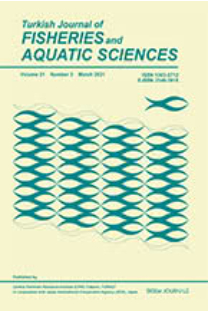Acute Toxicity of Fluazifop-P-Butyl (Herbicide) on Oreochromis niloticus(L., 1754) Larvae (Acknowledgements)
Fluazifop-P-Butyl (Herbisit)'in Oreochromis niloticus(L.,1754) Yavruları Üzerine Akut Toksik Etkisinin Araştırılması
___
- Atay, D. and Rad, F. 1998. Balıkçılık amenajmanı. Ankara Üniv. Ziraat Fak. Yay.: 1500, Ders Kitabı: 454, Ankara Üniv. Ziraat Fak. Halkla İlişkiler ve Yayın Ünitesi, Ankara, 182 s.
- European Standard EN 14 757, 2005: Water Quality— Sampling of Fish with Multimesh Gill nets, CEN TC 230, March 2005.
- Erzini, K., Gonçalves, J.M.S., Bentes, L., Moutopoulos, D.K., Hernando Casal, J.A., Soriguer, M.C., Puente, E., Errazkin, L. A., and Stergiou, K. I. 2006. Size selectivity of trammel nets in southern European small-scale fisheries. Fisheries Research, 79: 183-201. doi:10.1016/j.fishres.2006.03.004
- Fujimori, Y. and Tokai, T. 2001. Estimation of gillnet selectivity curve by maximum likelihood method. Fisheries Science, 67(4): 644-654. doi:10.1046/j.1444-2906.2001.00301.x
- Hamley, J.M. and Regier, H.A. 1973. Direct estimates of gillnet selectivity to walleye (Stizostedion vitreum vitreum). Journal of the Fisheries Research Board of Canada, 30: 817–830. doi: 10.1139/f73-137
- Hamley, J.M. 1975. Review of gillnet selectivity. Journal of the Fisheries Research Board of Canada, 32: 1943- 1969.doi: 10.1139/f75-233
- Hamley, J.M. 1980. Sampling with gill nets. In: T. Bachiel and R. L. Welcomme (Eds), Guidelines for Sampling Fish in Inland Waters. Technical Paper 33, FAO, European Inland Fisheries Advisory Commission, Rome, pp. 37–53.
- Huse, I., Løkkeborg, S., and Soldal, A.V. 2000. Relative selectivity in trawl, longline and gillnet fisheries for cod and haddock. ICES Journal of Marine Science 57:1271–1282. doi:10.1006/jmsc.2000.00813
- Kalaycı, F. and Yeşilçiçek, T. 2012. Investigation of the selectivity of trammel nets used in red mullet (Mullus barbatus) fishery in the Eastern Black Sea, Turkey. Turkish Journal of Fisheries and Aquatic Sciences 12: 937-945. doi: 10.4194/1303-2712-v12_4_21
- King, M.G. 2007. Fisheries biology, assessment and management. Blackwell Publishing Editorial Offices, Singapore, 382 pp.
- Kolding, J. and Skålevik, Å. 2011. PasGear 2. A database package for experimental or artisanal fishery data. Version 2.5. available at http://www.imr.no/forskning/bistandsarbeid/nansis /pasgear2/en
- McCombie, A.M. and Fry, F.E.J. 1960. Selectivity of gill nets for lake whitefish (Coregonus clupeaformis). Trans. Am. Fish. Soc., 89(2): 176–184. doi: 10.1577/1548-8659(1960)89[176:SOGNFL] 2.0.CO;2
- Millar, R.B. 1992. Estimating the size-selectivity of fishing gear by conditioning on the total catch. Journal of the American Statistical Association, 87: 962-968. doi: 10.1080/01621459.1992.10476250
- Millar, R.B. and Holst, R. 1997. Estimation of gillnet and hook selectivity using log-linear models. ICES Journal of Marine Science, 54: 471–477. doi: 10.1006/jmsc.1996.0196
- Millar, R.B. and Fryer, R.J. 1999. Estimating the sizeselection curves of towed gears, traps, nets and hooks. Reviews in Fish Biology and Fisheries, 9: 89-116. doi: 10.1023/A:1008838220001
- Özekinci, U., Begburs, C.R., and Tenekecioglu, E. 2003. An investigation of gill nets selectivity used in Capoeta capoeta umbla (Heckel, 1843) and Capoeta trutta (Heckel, 1843) (Siraz fish) fishery in Keban Dam Lake. Ege University, Ege Journal of Fisheries & Aquatic Sciences, 20: 473-479.
- Pet, J.S., Pet-Soede, C., and Densen, W.L.T. 1995. Comparison of methods for the estimation of gillnet selectivity to tilapia, cyprinids and other species of Sri Lankan reservoir fish. Fisheries Research, 24: 141- 164. doi: 10.1016/0165-7836(94)00364-3
- Petriki, O., Erzini, K., Moutopoulos, D.K., and Bobori, D.C. 2014. Gillnet selectivity for freshwater fish species in three lentic systems of Greece. J. Appl. Ichthyol., 30: 1016-1027. doi: 10.1111/jai.12476
- Psuty, I. and Borowski, W. 1997. The selectivity of gill nets to bream (Abramis brama L.) fished in the Polish part of the Vistula Lagoon. Fisheries Research, 32: 249- 261. doi: 10.1016/S0165-7836(97)00056-8
- Reddin, D.G. 1986. Effects of different mesh sizes on gillnet catches of Atlantic salmon in Newfoundland. North American Journal of Fisheries Management, 6: 209-215. doi:10.1577/1548- 8659(1986)6<209:EODMSO>2.0.CO;2
- Reis, E.G. and Pawson, M.G. 1992. Determination of gillnet selectivity for bass (Dicentrarchus labrax L.) using commercial catch data. Fisheries Research, 13: 173–187. doi: 10.1016/0165-7836(92)90025-O
- Santos, M.N.D., Gaspar, M., Monteiro, C.C., and Erzini, K. 2003. Gill net selectivity for European hake Merluccius merluccius from southern Portugal: implications for fishery management. Fisheries Science, 69: 873–882. doi: 10.1046/j.1444- 2906.2003.00702.x
- Siegel, S., Castellan Jr., N.J., 1988. Nonparametric Statistics for the Behavioral Sciences. McGraw-Hill International Editions, Statistics Series, second ed., p. 399.
- Spangler, G.R. and Collins J.J. 1992. Lake Huron fish community structure based on gill-net catches corrected for selectivity and encounter probability. North American Journal of Fisheries Management, 12: 585-597. doi:10.1577/1548- 8675(1992)012<0585:LHFCSB>2.3.CO;2
- Turan, D., Kottelat, M., Ekmekçi, F.G., and Imamoğlu H.O. 2006. A review of Capoeta tinca, with descriptions of two new species from Turkey (Teleostei: Cyprinidae). Revue Suisse de Zoologie, 113(2): 421-436.
- Van Densen, W.L.T. 1987. Gillnet selectivity to pikeperch, Stizostedion lucioperca (L.), and perch, Perca fluviatilis L., caught mainly wedged. Aquaculture Research, 18: 95–106. doi: 10.1111/j.1365- 2109.1987.tb00127.x
- Winters, G.H. and Wheeler, J.P. 1990. Direct and indirect estimation of gillnet selection curves of Atlantic herring (Clupea harengus harengus). Canadian Journal of Fisheries and Aquatic Sciences 47, 460- 470. doi: 10.1139/f90-050
- ISSN: 1303-2712
- Yayın Aralığı: 12
- Başlangıç: 2015
- Yayıncı: Su Ürünleri Merkez Araştırma Enstitüsü - Trabzon
Cansev AZGIN, Münir Ziya Lugal GÖKSU
Trammel Net Selectivity for FourBarbel Scraper Capoetabalikiin the Sakarya River, Turkey
Erdinç AYDIN, Abdullah Ekrem KAHRAMAN, DİDEM GÖKTÜRK, ADNAN AYAZ
DİLEK EDİGER, Çolpan Polat BEKEN, A. Muzaffer FEYZIOGLU, FATİH ŞAHİN, İbrahim TAN
Ertan DAĞLI, Güley ŞAHİN KURT, Murat Sezgin, Zeynep CENGİZ
Paraskevi-Niki LAMPRİ, Archontia CHATZİSPYROU, Kostas KAPIRIS
Gonzalo Rodríguez RODRIGUEZ, Roberto Bande RAMUDO
Priyanka Halder MALLICK, Susanta Kumar CHAKRABORTY
Robert CZERNİAWSKİ, Jozef DOMAGALA, Tomasz KREPSKİ, Ma?gorzata PILECKA RAPACZ
